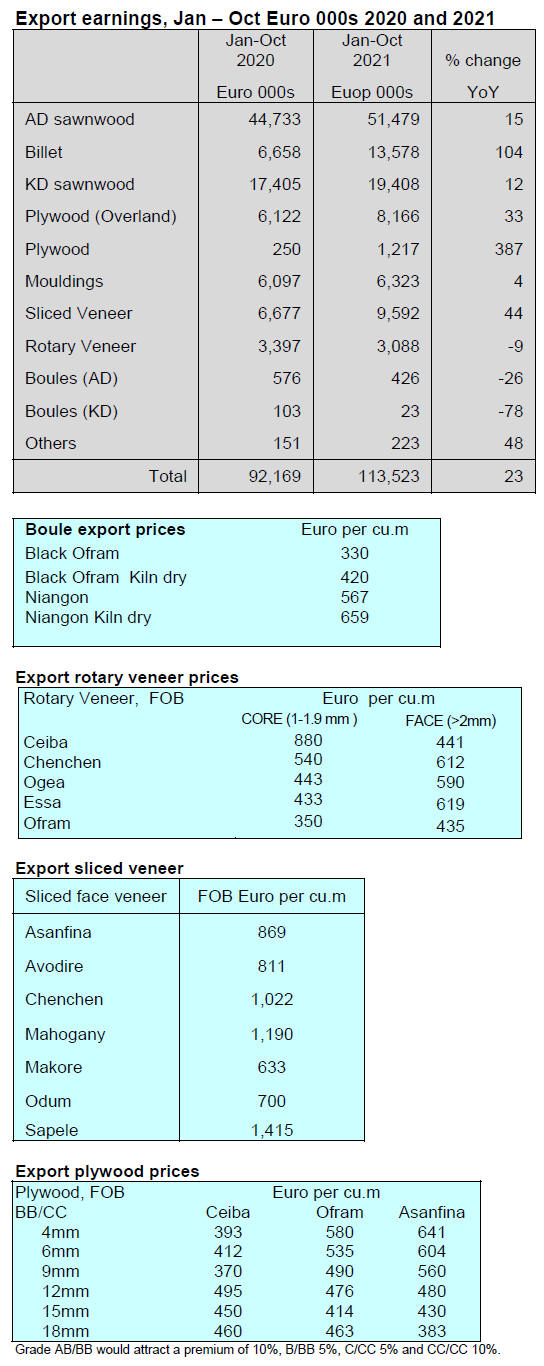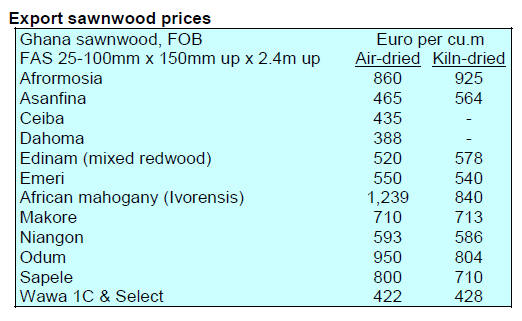|
1.
CENTRAL AND WEST AFRICA
End of rains in Cameroon, harvesting back on
schedule
Cameroon has, at last, started to welcome the beginning of
the dry season so harvesting conditions have improved.
Despite the rise in covid infections mills report no problem
with the work force and that production is back to normal
after the dismal situation during the extended rains. The
availability of containers for exports is still an issue and is
disrupting shipments and leading to a build in stocks of
sawnwood.
Large number of concession agreements withdrawn in
Gabon
The timber industry in Gabon is trying to assess the impact
of an announcement from the government on 17 January
withdrawing of a large number of concession agreements.
Companies affected reportedly have concession
agreements arranged many years ago and do not have the
appropriate documentation. This is likely to cause
considerable problems for the companies concerned.
Concession holders had just 8 days from 17 January to
respond.
As with Cameroon, the availability of containers is
hindering shipments from Gabon which producers say is
unfortunate as demand is firm in international markets.
According to the daily newspaper l'Union the governor of
Moyen-Ogooué Province, Barnabé Mbagalivoua, called a
crisis meeting with government labour officers and
workers' unions to decide action against a forestry
company which reportedly unfairly dismissed workers,
employed workers without a formal contract and also
failed to pay employee contributions to the National Social
Security Fund (CNSS).
See:
https://www.lenouveaugabon.com/fr/securite-justice/1701-17944-lambarene-des-exploitants-forestiers-chinois-interpellespour-violation-des-droits-des-employes
Rumours that felling tax to be raised in Congo
Opposition to the proposed log export quota in Congo set
to be introduced by the end of this year is growing with
exporters saying the 75%/25% quota needs to be
reconsidered.
Producers have indicated that there is a steady demand for
okoume especially and that buyers continue to show
interest in the redwoods such as sapelli and sipo. News is
circulating indicating changes in top management of the
forest authority have been made and that the change has
not impacted dealings between concessionaires and mills
and the government. In related news, it has been learnt that
the felling tax will be increased possibly in June this year.
Congo Basin certification system achieves PEFC
endorsement
The PEFC website has announced the Pan African Forest
Certification (PAFC) Congo Basin regional system has
achieved PEFC endorsement marking the first PEFC
regional forest certification system to be recognised.
PEFC says “members in Cameroon, Congo and Gabon
joined forces under the name of PAFC Congo Basin to
develop this regional certification system. The shared
language and the similar forestry conditions in the three
neighbouring countries enables them to share one system.
See:
https://pefc.org/news/pafc-congo-basin-regionalcertification-system-achieves-pefc-endorsement
ATIBT launches carbon commission
A wide range of stakeholders including producers, donors,
professional associations, certification bodies and various
experts recently met to discuss advancing an
understanding of carbon trading and carbon markets. One
of the main observations from the group was that forest
operators lack information on carbon financing and
dialogue with carbon market actors.
There were questions raised on the potential for carbon
storage through SFM in West African forests which it was
felt was not sufficient to be profitable at current prices.
The group identified objectives which were included in an
initial roadmap to address the overall objective.
See:
https://www.atibt.org/en/news/13114/launch-of-the-atibtcarbon-commission-making-the-link-between-forest-operatorsand-carbon-market-actors
Wood decking market study
Le Commerce du Bois has published the results of
a study conducted by Jean-Marc Mornas on prospects for
wood decking in France: ‘2017-2022 evolution, 2021
estimate and 2025 prospects’.
See:
https://www.lecommercedubois.org/files/upload/actualites/Marches/CP_Etude_Mornas_-_Marche_terrasse_bois_et_derives_2017_a_2021____VF_LCB.pdf
 
2.
GHANA
Wood product export markets
According to data from the Timber Industry Development
Division (TIDD), a total of 248,658 cu.m of wood
products were exported during the first 10-months of
2021. This compares to 179,835 cu.m recorded for the
same period in 2020 and was a 38% year on year growth.
The table below shows the market performance for 2021
compared to 2020.

Of the 248,658 cu.m shipments to Asia (63%), Europe
(17%) and Africa (12%) accounted for 92% of the total
export volume for the period with three other geographic
zones accounting for the balance.
Total shipments to the ECOWAS sub-region increased to
25,632 cu.m in 2021 from 21,541 cu.m in 2020, a growth
of 19% . The table below shows the ECOWAS market
destinations with their corresponding volume, value and
unit price.

Burkina Faso, Togo, Niger and Senegal were the leading
importers of Ghana’s wood products and recorded
significant volume growth in 2021 compared to 2020.
These countries together accounted for the 88% of the
total 25,632 cu.m shipped to ECOWAS member countries
in 2021.
The average unit price for ECOWAS member countries
trading with Ghana improved in 2021 compared to 2020,
except Gambia. The average price increased from
Euro342/cu,m in 2020 to Euro387/cu.m in 2021.
West African countries have for several years been the
major markets for Ghana’s plywood with Togo, Niger and
Burkina Faso topping the list. Currently, about 80% of
Ghana’s plywood exports are shipped to West African
markets.
Land use map to identify forest cover
The Forestry Commission, in partnership with local and
international agencies, has developed a land use map
which delivers a detailed view of the country’s forest
cover. Based on the latest map it has been established that
Ghana has a total of 6.5 million hectares of both open and
closed forests.
The land use map which, a project of the Resource
Management Support Center (RMSC) of the Forestry
Commission, received support of the UK space agency,
Ecometrica, the technical wing of the Forestry
Commission (Resource Support Center), Faculty of
Renewable Natural Resources of the Kwame University of
Science and Technology (KNUST) and the Forest
Research Institute of Ghana (FORIG).
See:
https://ghana-nationallanduse.knust.ourecosystem.com/interface/
Two online applications for forestry sector
The Forestry Commission has launched two online
applications; the Digitalised Property Mark Registration
and Renewal (e-property mark registration) and the
Electronic Wood Tracking System.
When launching the applications the Minister for Lands
and Natural Resources, Samuel A. Jinapor, said it is the
President’s vision to promote socio-economic
development through digitisation and the Forestry
Commission is playing its part.
The E- Property Mark Registration App. allows applicants
to register, renew and extend contracts online while the
electronic Wood Tracking System platform is designed to
track wood from the point of harvest to the point of sale in
order to ensure transparency and to be able to verify the
origin of wood products.
See:
https://fcghana.org/news_summary.php/
Correction, In addition to a duplication of tables our
correspondent has found some errors in the export
statistics he provided. Revised export volume and value
tables are provided below.
 

3. MALAYSIA
Reduce dependence on natural forest resources
says
minister
Malaysia recorded a slight increase in earnings from
timber exports between January and October 2021
compared to 2020. Among the products that contributed
most were wooden furniture, sawnwood, plywood and
mouldings.
The Ministry of Plantation Industries and Commodities
(MPIC) aims to achieve RM24 bil. from timber exports in
2022 as the industries take advantage of the latest
advanced technologies, introduce new products and solve
the problem of finding skilled workers.
MPIC Deputy Minister, Willie Mongin, called on the
industry to be imaginative in coming up with alternative
raw material thus reducing dependence on tropical timber
and rubberwood. He also stressed the importance of
providing good accommodation for workers in order to
meet the Workers' Minimum Standards of Housing and
Amenities Act 1990 (Act 446).
See:https://www.nst.com.my/news/nation/2022/01/763184/malaysiagained-rm179-billion-timber-exports-2021?topicID=1&articleID=763184
Regional Comprehensive Economic Partnership
(RCEP)
The timber industry is looking at RCEP as a new driver of
Malaysian domestic and international business activities in
the post-pandemic period. Malaysia is likely to be the 12th
RCEP signatory as the Instrument of Ratification was
submitted to the ASEAN Secretariat on 17 January. RCEP
will enter into force for Malaysia on18 March 2022 as
Malaysia joins 11 other signatories Singapore, China,
Japan, Brunei, Cambodia, Laos, Thailand, Vietnam,
Australia, New Zealand and South Korea.
| 
